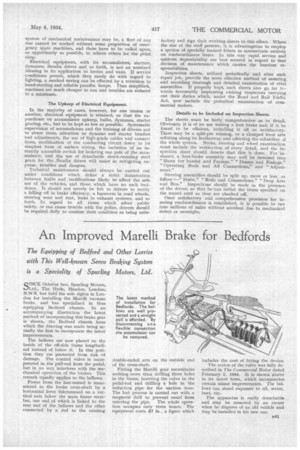An Improved Marelli Brake for Bedfords
Page 55

If you've noticed an error in this article please click here to report it so we can fix it.
The Equipping of Bedford and Other Lorries with This Well-known Servo Braking System is a Speciality of Soiling Motors, Ltd.
SINCE October last, Spurling Motors, Ltd., The Hyde, Hendon, London, N.W.9, has held the sole rights in London for installing the Marelli vacuum brake, and has specialized in thus
equipping Bedford chassis. In an accompanying illustration the latest
method of incorporating this brake gear is shown, the Bedford chassis from which the drawing was made being actually the first to incorporate the latest improvements.
The bellows are now placed on the inside of the off-side frame longitudinal instead of below it. In this position they are protected from risk of damage. The control valve is incorporated in the pull-rod from the pedal, but in no way interferes with the mechanical operation of the brakes. This remark equally applies to the bellows.
Power from the last-named is transmitted to the brake cross-shaft by a horizontal lever fulcrummed on a vertical axis below the main frame member, one end of which is linked to the rear end of the bellows and the other connected by a rod to the existing double-endedarm on the outside end of the cross-shaft.
Fitting the Marelli gear necessitates nothing more than drilling three holes in the frame, inserting the valve in the pedal-rod and drilling a hole in the induction pipe for the suction hose. The last process is carried out with a magnetic drill to prevent swan f from entering the pipe. The whole operation occupies only three hours. The equipment costs 47 5s., a figure which includes the cost of fitting the device.
The action of the valve was fully described in The Commercial Motor dated February 2, 1934. It is shown above in its latest form, which incorporates certain minor improvements. The bellows can stand exposure to oil, water, heat, etc.
The apparatus is easily detachable and may be removed by an owner when he disposes of an old vehicle and may be installed in his new one.




























































































